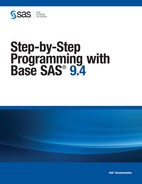Understanding Output
Output from Procedures
When you invoke a SAS procedure, SAS analyzes or processes
your data. You can read a SAS data set, compute statistics, print
results, or create a new data set. One of the results of executing
a SAS procedure is creating procedure output. The location of procedure
output varies with the method of running SAS, the operating environment,
and the options that you use. The form and content of the output varies
with each procedure. Some procedures, such as the SORT procedure,
do not produce printed output.
SAS has numerous procedures
that you can use to process your data. For example, you can use the
PRINT procedure to print a report that lists the values of each variable
in your SAS data set. You can use the MEANS procedure to compute descriptive
statistics for variables across all observations and within groups
of observations. You can use the UNIVARIATE procedure to produce information
about the distribution of numeric variables. For a graphic representation
of your data, you can use the CHART procedure. Many other procedures
are available through SAS.
Output from DATA Step Applications
Although
output is usually generated by a procedure, you can also generate
output by using a DATA step application. Using the DATA step, you
can do the following:
To generate output,
you can use the FILE and PUT statements together within the DATA step.
Use the FILE statement to identify your current output file. Then
use the PUT statement to write lines that contain variable values
or text strings to the output file. You can write the values in column,
list, or formatted style.
You can use the FILE
and PUT statements to target a subset of data. If you have a large
data set that includes unnecessary information, this type of DATA
step processing can save time and computer resources. Write your code
so that the FILE statement executes before a PUT statement in the
current execution of a DATA step. Otherwise, your data is written
to the SAS log.
If you have a SAS data
set, you can use the FILE and PUT statements to create an external
file that another computer language can process. For example, you
can create a SAS data set that lists the test scores for high school
students. You can then use this file as input to a Fortran program
that analyzes test scores. The following table lists the variables
and the column positions that an existing Fortran program expects
to find in the input SAS data set:
Output from the Output Delivery System (ODS)
Beginning with Version
7, procedure output is much more flexible because of the Output Delivery
System (ODS). ODS is a method of delivering output in a variety of
formats and of making the formatted output easy to access. Important
features of ODS include the following:
-
ODS combines raw data with one or more table definitions to produce one or more output objects. When you send these objects to any or all ODS destinations, your output is formatted according to the instructions in the table definition. ODS destinations can produce an output data set, traditional monospace output, output that is formatted for a high-resolution printer, output that is formatted in HyperText Markup Language (HTML), and so on.
-
ODS provides a way for you to choose individual output objects to send to ODS destinations. For example, PROC UNIVARIATE produces five output objects. You can easily create HTML output, an output data set, traditional Listing output, or Printer output from any or all of these output objects. You can send different output objects to different destinations.
In addition, ODS removes
responsibility for formatting output from individual procedures and
from the DATA step. The procedure or DATA step supplies raw data and
the name of the table definition that contains the formatting instructions.
Then ODS formats the output. Because formatting is now centralized
in ODS, the addition of a new ODS destination does not affect any
procedures or the DATA step. As future destinations are added to ODS,
they will automatically become available to the DATA step and to all
procedures that support ODS.
For more information
and examples, see Understanding and Customizing SAS Output: The Output Delivery System (ODS).
..................Content has been hidden....................
You can't read the all page of ebook, please click here login for view all page.
